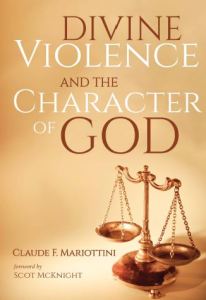Paul Copan on Divine Violence

Today’s guest post was written by Paul Copan. His essay is a review of my book Divine Violence and the Character of God. Paul is a professor at the Palm Beach Atlantic University (Florida) and holds the endowed Pledger Family Chair of Philosophy and Ethics. He is author or editor of more than 40 books, including his well-known book, Is God a Moral Monster?
Some Reflections on Claude Mariottini’s
Divine Violence and the Character of God
Paul Copan
As someone who has written on difficult Old Testament texts, I consider Claude Mariottini to be a comrade-in-arms. I have drawn on his work over the years, reading his blog posts with great interest—particularly those that interact with Greg Boyd’s problematic two-volume work on Old Testament violence, The Crucifixion of the Warrior God (Fortress Press 2017).
I had been working on my forthcoming book Is God a Vindictive Bully? Reconciling Portrayals of God in the Old and New Testaments (Baker Academic, 1 Oct. 2022), and I noticed somewhere online that Claude had written the book, Divine Violence and the Character of God. I wrote him immediately to see if I could obtain an electronic copy of his book prior to its publication. He kindly sent it, and I was glad to interact with the book’s contents, which largely reinforced what I was saying about violence in Scripture while challenging some of the same detractors. And I am glad to put in a strong word for the book here at Claude’s blog site.
I noticed immediately that the foreword was written by Claude’s Northern Baptist Theological Seminary colleague (and my former New Testament professor at Trinity Seminary) Scot McKnight. I was quite intrigued by this since Scot had written quite sympathetically—too sympathetically, to my mind—about Greg Boyd’s creative attempts to come to terms with Old Testament violence.
Having read and interacted with Boyd’s book thoroughly, I detected in Boyd certain Marcionite leanings. Indeed, Boyd himself acknowledges his sympathy with the spirit of Marcionism (in his Crucifixion book: pp. 46-47). For example, Boyd (following Old Testament scholar Eric Seibert) makes a radical distinction between the “textual God” of the fallen, violence-prone biblical author or prophet and the “actual God” reflected in Jesus’s enemy-loving cry from the cross, “Father, forgive them.” Also, rather than seeing Jesus rejecting a misuse of Moses in Matthew 5, Boyd actually pits Jesus against Moses here. Furthermore, Boyd also has a troubling view of inspiration. For example, he claims that the oft-repeated Old Testament statement “thus says the Lord” often means nothing more than “thus says Moses” or “thus says Joshua.” Boyd even castigates the apostle Paul for his thirst for vengeance in 2 Thessalonians 2:6-8.
Now, I’m not saying—and neither is Claude or Scot—that the problems of Old Testament “violence” can be easily “resolved” or that all tensions are readily eased. Scot acknowledges this, writing in the foreword: “All I want is for my co-strugglers-with-these-texts to face the texts squarely, admit the realities of the violence, and think about it in a Christian and moral manner. The challenge for all of us is [to] square the violence with the vision of Jesus in the Sermon on the Mount or in his moral summons to cruciformity or Christoformity” (p. x).
With all of this as a backdrop, here are a few of my reflections on Claude’s superb book.
1) Mariottini pushes hard against those like Boyd, Seibert, et al., who treat God as a pacifist—a view that distorts large swaths of the Old Testament that describe God’s character and activity in the world:
If pacifism and kingdom ethics become the lens by which the Old Testament is interpreted, then almost every text in the Old Testament will be considered offensive because they will be contrary to the teachings of Jesus. Then, every text in which God takes action to deliver his people will be contrary to the pacifist’s view of a non-violent view of God (p. 46).
By contrast, other Christian pacifists at least acknowledge (the actual) God’s judgment in the Old Testament. For example, Mariottini cites the late Old Testament scholar Peter Craigie: “the expelling of the Canaanites from Palestine was not to be understood as an arbitrary divine act, but as an act of judgment by a just God” (p. 245).
2) This point builds on the first. Claude’s portrayal of Boyd, Seibert, et al. is even-handed, but he points out their highly selective approach. They resort to a kind of cherry-picking of texts that suit their narrowed-down Anabaptistic theology. He rightly points out that there is no contradiction between the Warrior God of the Old Testament and how God is portrayed in the New. Paul’s words in Romans 11:22 are relevant across both testaments: “Behold then the kindness and severity of God.”
Claude quotes certain biblical scholars to reinforce this point about the New Testament’s emphasis on divine severity:
These writers [Boyd, et al.] emphasize that Jesus and the God revealed in Christ are nonviolent. However, this seems to contradict some of the evidence found in the New Testament. In his article “God and Violence in the Old Testament,” Fretheim writes, “The Old Testament has a reputation: it is a book filled with violence, including the violence of God. The New Testament commonly avoids such a charge; but it, too, is filled with violent words and deeds, and Jesus and the God of the New Testament are complicit in this violence.” Aichele says that “Each of the synoptic gospels portrays Jesus as a violent man, one who contests violently with others.”
In his evaluation of the argument that the God of the Bible is nonviolent because Jesus taught nonviolence, Belousek writes,
One can conclude with certainty that God is nonviolent because Jesus is nonviolent only if one gives absolute weight to the Gospel traditions of a healing, forgiving, non-resisting, non-retaliating Jesus and zero weight to the multiple traditions of a judging, punishing, destroying, and killing Jesus—an obviously biased weighing of the evidence. If one assigns a non-zero weight to the latter traditions of textual evidence, the upshot is that any argument inferring a nonviolent God from a nonviolent Jesus will be only as convincing as one’s interpretation of the scriptural traditions of Jesus the divine judge (p. 44).
3) I appreciate Claude’s realistic assessment about comparing modern Western mindset with that of the ancient Near East. This is particularly helpful when assessing the neo-Marcionite leanings of the interpreters Claude is examining. He rightly maintains that these scholars “interpret the Old Testament as Americans living in a country whose culture is completely different from the culture of the people who lived in the land of Canaan more than three thousand years ago” and “as Christians whose lives have been transformed by the gospel and whose religious values are completely different from the people who worshiped God in a tabernacle” (p. 48).
C.S. Lewis warned against chronological snobbery—an assessment reflected in an epigram in Alexander Pope’s Essay on Criticism (Part II):
We think our fathers fools, so wise we grow;
Our wiser sons, no doubt, will think us so.
I hasten to add that while Boyd and his compatriots aren’t being chronological snobs, as they would see themselves influenced by the same ancient Near Eastern cultural and historical forces if they lived back then. However, the problem is that they use a highly Christianized or Christ-influenced cultural lens by which to assess what they find troubling in the Old Testament text.
4) When Claude himself speaks about “divine violence,” we must qualify this. The Old Testament doesn’t ascribe violence (hamas) to God, but only to wicked, oppressive human beings. Some thinkers such as Daniel Hawk note that divine severity is typically God’s last-resort action in response to tyranny, criminality, and dehumanization. It is humans that are “violent.” So Hawk and others refer to this as “divine counter-violence”—which is reluctantly engaged in.
5) I appreciate Claude’s affirmation that God does indeed suffer, which is, for example, seen in his disappointment with ancient Israel—as expressed through the prophets (pp. 64-65). The Old Testament Scriptures also portray God as making himself vulnerable (pp. 65-66). Indeed, they present him as weeping and lamenting at Israel’s disobedience (pp. 68-70).
6) Claude is undaunted by difficult issues—“genocide,” warfare, cannibalism, ripping open pregnant women, covenant curses (chapters 13-19). He faces them squarely, and these immensely valuable chapters carefully unpack the reality of God’s judgment for disobedience, noting that divine harshness toward Israel and other nations is not surprising but measured. God renders to each person or nation according to their deeds. This is all the more the case with Israel, as it had had clearly articulated covenantal warnings about very specific judgments for disobedience.
Claude gives an excellent summary of what is going on in these “violent” scriptural texts:
Yahweh did use violence in his work of reconciliation. However, the use of violence was necessary when everything else failed. Israel provoked God to anger but they did so to their own harm (Jer 25:6–7). When God brought judgment upon his people, he did so with tears in his eyes. When God had to punish nations, he lamented their suffering and suffered with them. In the end, I hope to show that Yahweh, the Divine Warrior, is not “a diabolic violent warrior god,” but “a God merciful and gracious, slow to anger, and abounding in steadfast love and faithfulness” (p. xvii).
This are just a few of my reflections on just some of the nuggets of insight and wisdom that come from Claude’s excellent, biblically-grounded treatment of a difficult topic. I highly recommend it!
Paul Copan
I would like to thank Paul for his review and his endorsement of my book.
Enter to Win a Free Copy of my Book Divine Violence and the Character of God.
Claude Mariottini
Emeritus Professor of Old Testament
Northern Baptist Seminary
NOTE: Did you like this post? Do you think other people would like to read this post? Be sure to share this post on Facebook and share a link on Twitter or Tumblr so that others may enjoy reading it too!
I would love to hear from you! Let me know what you thought of this post by leaving a comment below. Be sure to like my page on Facebook, follow me on Twitter, follow me on Tumblr, Facebook, and subscribe to my blog to receive each post by email.
If you are looking for other series of studies on the Old Testament, visit the Archive section and you will find many studies that deal with a variety of topics.











